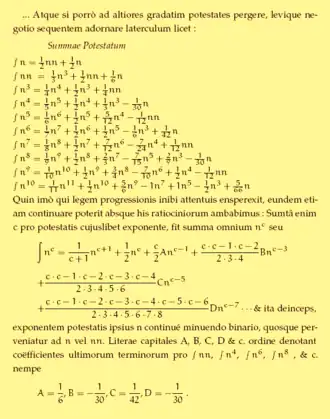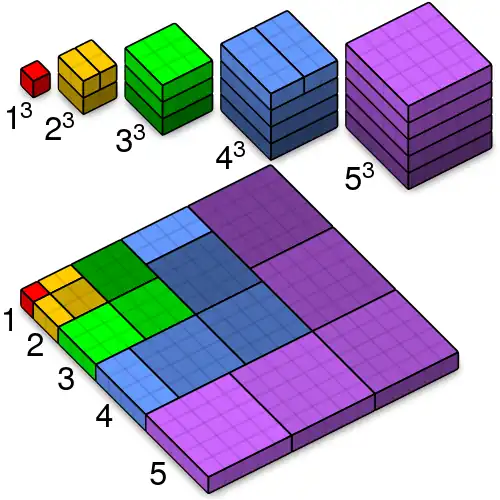In mathematics, Faulhaber's formula, named after the early 17th century mathematician Johann Faulhaber, expresses the sum of the p-th powers of the first n positive integers
as a polynomial in n. In modern notation, Faulhaber's formula is
Here, is the binomial coefficient "p + 1 choose r", and the Bj are the Bernoulli numbers with the convention that .
The result: Faulhaber's formula
Faulhaber's formula concerns expressing the sum of the p-th powers of the first n positive integers
as a (p + 1)th-degree polynomial function of n.
The first few examples are well known. For p = 0, we have
For p = 1, we have the triangular numbers
For p = 2, we have the square pyramidal numbers
The coefficients of Faulhaber's formula in its general form involve the Bernoulli numbers Bj. The Bernoulli numbers begin
where here we use the convention that . The Bernoulli numbers have various definitions (see Bernoulli number#Definitions), such as that they are the coefficients of the exponential generating function
Then Faulhaber's formula is that
Here, the Bj are the Bernoulli numbers as above, and
is the binomial coefficient "p + 1 choose k".
Examples
So, for example, one has for p = 4,
The first seven examples of Faulhaber's formula are
History
Faulhaber's formula is also called Bernoulli's formula. Faulhaber did not know the properties of the coefficients later discovered by Bernoulli. Rather, he knew at least the first 17 cases, as well as the existence of the Faulhaber polynomials for odd powers described below.[1]

In 1713, Jacob Bernoulli published under the title Summae Potestatum an expression of the sum of the p powers of the n first integers as a (p + 1)th-degree polynomial function of n, with coefficients involving numbers Bj, now called Bernoulli numbers:
Introducing also the first two Bernoulli numbers (which Bernoulli did not), the previous formula becomes
using the Bernoulli number of the second kind for which , or
using the Bernoulli number of the first kind for which
Faulhaber himself did not know the formula in this form, but only computed the first seventeen polynomials; the general form was established with the discovery of the Bernoulli numbers.
A rigorous proof of these formulas and Faulhaber's assertion that such formulas would exist for all odd powers took until Carl Jacobi (1834), two centuries later.
Proof with exponential generating function
Let
denote the sum under consideration for integer
Define the following exponential generating function with (initially) indeterminate
We find
This is an entire function in so that can be taken to be any complex number.
We next recall the exponential generating function for the Bernoulli polynomials
where denotes the Bernoulli number with the convention . This may be converted to a generating function with the convention by the addition of to the coefficient of in each ( does not need to be changed):
It follows immediately that
for all .
Faulhaber polynomials
The term Faulhaber polynomials is used by some authors to refer to another polynomial sequence related to that given above.
Write
Faulhaber observed that if p is odd then is a polynomial function of a.

For p = 1, it is clear that
For p = 3, the result that
is known as Nicomachus's theorem.
Further, we have
(see OEIS: A000537, OEIS: A000539, OEIS: A000541, OEIS: A007487, OEIS: A123095).
More generally,
Some authors call the polynomials in a on the right-hand sides of these identities Faulhaber polynomials. These polynomials are divisible by a2 because the Bernoulli number Bj is 0 for odd j > 1.
Inversely, writing for simplicity , we have
and generally
Faulhaber also knew that if a sum for an odd power is given by
then the sum for the even power just below is given by
Note that the polynomial in parentheses is the derivative of the polynomial above with respect to a.
Since a = n(n + 1)/2, these formulae show that for an odd power (greater than 1), the sum is a polynomial in n having factors n2 and (n + 1)2, while for an even power the polynomial has factors n, n + ½ and n + 1.
Expressing products of power sums as linear combinations of power sums
Products of two (and thus by iteration, several) power sums can be written as linear combinations of power sums with either all degrees even or all degrees odd, depending on the total degree of the product as a polynomial in , e.g. . Note that the sums of coefficients must be equal on both sides, as can be seen by putting , which makes all the equal to 1. Some general formulae include:
Note that in the second formula, for even the term corresponding to is different from the other terms in the sum, while for odd , this additional term vanishes because of .
Matrix form
Faulhaber's formula can also be written in a form using matrix multiplication.
Take the first seven examples
Writing these polynomials as a product between matrices gives
where
Surprisingly, inverting the matrix of polynomial coefficients yields something more familiar:
In the inverted matrix, Pascal's triangle can be recognized, without the last element of each row, and with alternating signs.
Let be the matrix obtained from by changing the signs of the entries in odd diagonals, that is by replacing by , let be the matrix obtained from with a similar transformation, then
and
Also
This is because it is evident that and that therefore polynomials of degree of the form subtracted the monomial difference they become .
This is true for every order, that is, for each positive integer m, one has and Thus, it is possible to obtain the coefficients of the polynomials of the sums of powers of successive integers without resorting to the numbers of Bernoulli but by inverting the matrix easily obtained from the triangle of Pascal.[3][4]
Variations
- Replacing with , we find the alternative expression:
- Subtracting from both sides of the original formula and incrementing by , we get
- where can be interpreted as "negative" Bernoulli numbers with .
- We may also expand in terms of the Bernoulli polynomials to find which impliesSince whenever is odd, the factor may be removed when .
- It can also be expressed in terms of Stirling numbers of the second kind and falling factorials as[5] This is due to the definition of the Stirling numbers of the second kind as mononomials in terms of falling factorials, and the behaviour of falling factorials under the indefinite sum.
Interpreting the Stirling numbers of the second kind, , as the number of set partitions of into parts, the identity has a direct combinatorial proof since both sides count the number of functions with maximal. The index of summation on the left hand side represents , while the index on the right hand side is represents the number of elements in the image of f.
- There is also a similar (but somehow simpler) expression: using the idea of telescoping and the binomial theorem, one gets Pascal's identity:[6]
- This in particular yields the examples below – e.g., take k = 1 to get the first example. In a similar fashion we also find
Relationship to Riemann zeta function
Using , one can write
If we consider the generating function in the large limit for , then we find
Heuristically, this suggests that
This result agrees with the value of the Riemann zeta function for negative integers on appropriately analytically continuing .
Umbral form
In the umbral calculus, one treats the Bernoulli numbers , , , … as if the index j in were actually an exponent, and so as if the Bernoulli numbers were powers of some object B.
Using this notation, Faulhaber's formula can be written as
Here, the expression on the right must be understood by expanding out to get terms that can then be interpreted as the Bernoulli numbers. Specifically, using the binomial theorem, we get
A derivation of Faulhaber's formula using the umbral form is available in The Book of Numbers by John Horton Conway and Richard K. Guy.[8]
Classically, this umbral form was considered as a notational convenience. In the modern umbral calculus, on the other hand, this is given a formal mathematical underpinning. One considers the linear functional T on the vector space of polynomials in a variable b given by Then one can say
See also
Notes
- ↑ Donald E. Knuth (1993). "Johann Faulhaber and sums of powers". Mathematics of Computation. 61 (203): 277–294. arXiv:math.CA/9207222. doi:10.2307/2152953. JSTOR 2152953. The arxiv.org paper has a misprint in the formula for the sum of 11th powers, which was corrected in the printed version. Correct version.
- ↑ Gulley, Ned (March 4, 2010), Shure, Loren (ed.), Nicomachus's Theorem, Matlab Central
- ↑ Pietrocola, Giorgio (2017), On polynomials for the calculation of sums of powers of successive integers and Bernoulli numbers deduced from the Pascal's triangle (PDF).
- ↑ Derby, Nigel (2015), "A search for sums of powers", The Mathematical Gazette, 99 (546): 416–421, doi:10.1017/mag.2015.77, S2CID 124607378.
- ↑ Concrete Mathematics, 1st ed. (1989), p. 275.
- ↑ Kieren MacMillan, Jonathan Sondow (2011). "Proofs of power sum and binomial coefficient congruences via Pascal's identity". American Mathematical Monthly. 118 (6): 549–551. arXiv:1011.0076. doi:10.4169/amer.math.monthly.118.06.549. S2CID 207521003.
- ↑ Guo, Victor J. W.; Zeng, Jiang (30 August 2005). "A q-Analogue of Faulhaber's Formula for Sums of Powers". The Electronic Journal of Combinatorics. 11 (2). arXiv:math/0501441. Bibcode:2005math......1441G. doi:10.37236/1876. S2CID 10467873.
- ↑ John H. Conway, Richard Guy (1996). The Book of Numbers. Springer. p. 107. ISBN 0-387-97993-X.
External links
- Jacobi, Carl (1834). "De usu legitimo formulae summatoriae Maclaurinianae". Journal für die reine und angewandte Mathematik. Vol. 12. pp. 263–72.
- Weisstein, Eric W. "Faulhaber's formula". MathWorld.
- Johann Faulhaber (1631). Academia Algebrae - Darinnen die miraculosische Inventiones zu den höchsten Cossen weiters continuirt und profitiert werden. A very rare book, but Knuth has placed a photocopy in the Stanford library, call number QA154.8 F3 1631a f MATH. (online copy at Google Books)
- Beardon, A. F. (1996). "Sums of Powers of Integers" (PDF). American Mathematical Monthly. 103 (3): 201–213. doi:10.1080/00029890.1996.12004725. Retrieved 2011-10-23. (Winner of a Lester R. Ford Award)
- Schumacher, Raphael (2016). "An Extended Version of Faulhaber's Formula" (PDF). Journal of Integer Sequences. Vol. 19.
- Orosi, Greg (2018). "A Simple Derivation Of Faulhaber's Formula" (PDF). Applied Mathematics E-Notes. Vol. 18. pp. 124–126.
- A visual proof for the sum of squares and cubes.